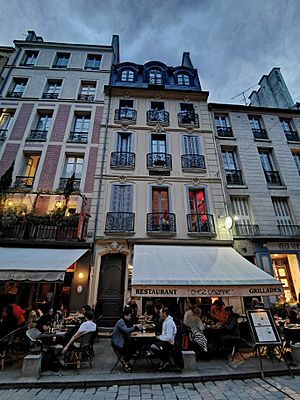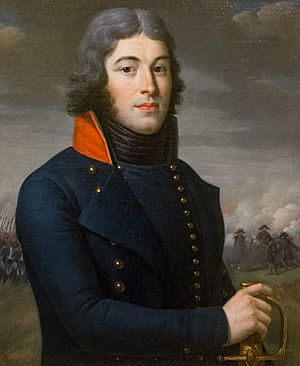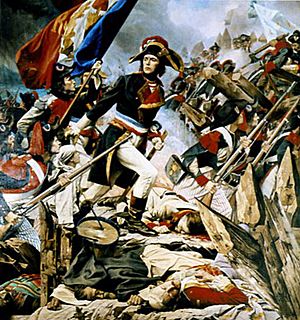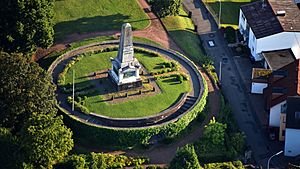Lazare Hoche facts for kids
Quick facts for kids
Lazare Hoche
|
|
|---|---|
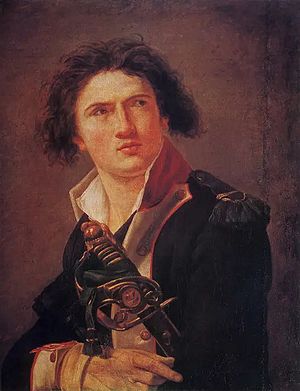
Portrait attributed to Jacques-Louis David, 1793
|
|
| Born | 24 June 1768 Versailles, France |
| Died | 19 September 1797 (aged 29) Wetzlar, Holy Roman Empire |
| Allegiance | |
| Service/ |
Army |
| Years of service | 1784–1797 |
| Rank | General of division |
| Commands held | Army of Moselle Army of the Rhine Army of the Coasts of Cherbourg Army of the Coasts of Brest Army of the West Army of the Coasts of the Ocean Army of Sambre and Meuse |
| Battles/wars | French Revolutionary Wars |
| Other work | Minister of War |
| Signature | |
Louis Lazare Hoche (born June 24, 1768 – died September 19, 1797) was an important French military leader during the French Revolutionary Wars. He was known for his victories, especially against forces loyal to the king in Brittany. His name is even carved on the famous Arc de Triomphe in Paris. A historian named Richard Holmes said Hoche was a very smart and talented general whose early death was a big loss for France.
Contents
Early Life and Beginnings
Lazare Hoche was born on June 24, 1768, in a village called Montreuil, which is now part of Versailles, France. His mother, Anne Merlière, and father, Louis Hoche, who worked as a stable servant for the king, raised him.
Sadly, his mother passed away when he was only two years old. Lazare was then mostly raised by his aunt, who sold fruit in Montreuil. His uncle, Abbé Merlière, who was a priest, helped educate him. He even arranged for Lazare to become a choirboy at his church.
Joining the Army
In 1782, Hoche started working as an assistant at the royal stables. However, he soon decided to join the Army. In October 1784, he became a fusilier (a type of soldier) in the French Guards regiment. He had originally wanted to serve with troops in the East Indies.
He quickly moved up the ranks. In November 1785, he was promoted to grenadier, and then to corporal in May 1789. This was just before the start of the French Revolution.
After the French Guards were disbanded when the Revolution began, Hoche joined the new National Guard in September 1789. During the October Days protests, he was among the Guardsmen who escorted King Louis XVI and his family out of the Palace of Versailles. After that, he served in different infantry regiments until he received a special military commission in 1792.
French Revolutionary Wars
Fighting in Flanders
Hoche first saw military action in 1792 as a lieutenant during the defense of Thionville. This was in the early part of the Flanders campaign of the Revolutionary Wars. He also took part in the Siege of Namur later that year.
He showed great skill during the Siege of Maastricht. Because of his talent, he became an aide-de-camp (a personal assistant) to General Le Veneur in March 1793. He continued to show his bravery at the Battle of Neerwinden later that month.
When General Charles Dumouriez switched sides to the Austrians, Hoche and others were suspected of disloyalty. He was arrested in August but released soon after. He then helped successfully defend Dunkirk. For this, he was quickly promoted to colonel, then to brigade general in September, and finally to general of division in October 1793.
In November, Hoche was put in charge of the Army of the Moselle. Within weeks, he was leading his army in Lorraine. His first major battle was at Kaiserslautern in November 1793 against the Prussians. The French lost, but even during the scary Reign of Terror, the government kept Hoche in command. They valued his determination and energy.
Hoche soon proved them right. On December 22, 1793, he won the Battle of Froeschwiller. The government representatives with his army immediately gave him command of the Army of the Rhine as well. In the Second Battle of Wissembourg on December 26, 1793, his French forces pushed the Austrian army out of Alsace. Hoche continued his success, driving the enemy back to the middle Rhine River in just four days. He then settled his troops for winter.
Arrest and Release
Before the next military campaign began, Hoche married Anne Adelaïde Dechaux on March 11, 1794. The day before his wedding, he was asked to command the Army of Italy. However, when he arrived in Nice to take the job, he was arrested. He was accused of disloyalty by Charles Pichegru, who had been removed from command of the Army of the Rhine.
Hoche was sent to Carmes Prison in Paris on April 11, then moved to another prison called the Conciergerie. He was finally released on August 4, after the fall of Maximilien Robespierre and the end of the Reign of Terror.
Ending Civil War in France
Soon after his release, Hoche was given command of the Army of the Coasts of Cherbourg. His mission was to stop the Royalist (king-loyal) uprising in a region called the Vendée. He set up his main base in Rennes, Brittany, and focused on organizing his troops. In November 1794, he also received command of the Army of the Coasts of Brest.
Hoche quickly brought peace to the area with the Treaty of La Jaunaye in February 1795. However, the war soon started again because of the rebel leaders.
Between June and July 1795, Hoche led the defense against the Quiberon Expedition. This was an attempt by Royalist exiles, helped by the British Navy, to invade France. Hoche decisively defeated them at Fort Penthièvre on July 21. In late August, he was put in charge of the Army of the West. He was ordered to attack the rebel army led by François de Charette.
In December 1795, Hoche gained full control over all French forces in Western France. This happened when he became commander of the new Army of the Coasts of the Ocean, which combined three armies he already commanded.
After this, using well-organized mobile groups of soldiers, he slowly defeated the Catholic and Royal Armies. Hoche led the operations that resulted in the capture and later execution of rebel leaders François Charette (February 24, 1796) and Jean-Nicolas Stofflet (March 23). This brought an end to the War in the Vendée. With the surrender of the leaders of the Chouannerie (another rebellion), Hoche successfully brought peace to Western France in May and June 1796. This region had been in a civil war for over three years.
Ireland Expedition

On July 20, 1796, the French government, called the French Directory, rewarded Hoche for his great service. On that same day, he was chosen to organize and lead the Expedition to Ireland. The goal was to help the United Irishmen rebel against British rule in Ireland. On October 16, he survived an assassination attempt in Rennes when someone shot at him but missed.
In Brest, Hoche gathered an army and forty-eight ships for the expedition. The fleet set sail for Ireland on December 15, 1796. Hoche was on the frigate Fraternité. However, a strong storm separated his ship from the rest of the expedition the day after they left. His ship was also chased by a British ship. By the time the Fraternité reached the Irish coast on December 30, the rest of the expedition had already scattered after failing to land. The Fraternité returned to France on January 11, 1797, without achieving its goal.
Hoche spoke with Wolfe Tone, a leader of the United Irishmen who was supposed to land with him in Ireland. They talked about the violent path the Revolution had taken. Tone was "heartily glad" to find Hoche was "of a humane temperament" (kind). Tone wrote in his memoirs that Hoche said: "great harm had been done to the ideas of liberty and more difficulties were put in the way of the French Revolution, by the amount of blood spilled: 'for,' he added, 'if you execute a man, you get rid of one person, it is true, but then you make all his friends and connections enemies forever of the government'."
Later Military Career
When he returned, Hoche was immediately sent to the Rhine border. He became commander of the Army of Sambre and Meuse. There, he defeated the Austrians at the Battle of Neuwied on April 18, 1797. However, military operations soon ended because of a peace agreement.
In July 1797, Hoche was appointed Minister of War by the Directory. In this role, he found himself caught up in complicated political plots. He realized he was being used by Paul Barras and was technically breaking the constitution. So, he resigned after less than a month in office and returned to his command on the Rhine border.
Death and Funeral
On September 2, Hoche received command of the Army of the Rhine and Moselle. He set up his headquarters in Wetzlar, near Koblenz. After returning from Frankfurt on September 13, his health quickly worsened. He died in Wetzlar on September 19 from consumption (which is another name for tuberculosis). He was only 29 years old.
Many people believed he had been poisoned, but there was no real proof of this. He was buried four days later next to his friend François Marceau at Fort Petersberg in Koblenz.
A large funeral procession for Hoche was held on the Champ de Mars in Paris on October 1. In 1919, the French Army, which was occupying the Rhineland at the time, reburied his remains. They moved them to the Monument General Hoche in Weißenthurm, near Neuwied. This was where he had started his last campaign against the Austrians.
Memorials

Lazare Hoche is remembered with a statue in Place Hoche, a park-like square near the main entrance to the Palace of Versailles. There is another statue of him in the Louvre Palace. A third statue, which was the last major work by artist Jules Dalou, is located in Quiberon, Brittany.
Inside Les Invalides in Paris, there is also a memorial dedicated to Hoche. A station on the Paris Metro subway system is named Hoche.
Hoche's personal motto was Res non verba. This is Latin for "Deeds, not words."
See also
In Spanish: Lazare Hoche para niños


